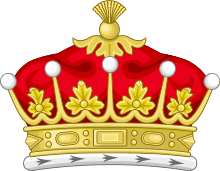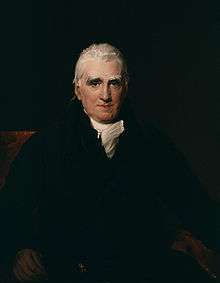Earl of Eldon
Earl of Eldon, in the County Palatine of Durham, is a title in the Peerage of the United Kingdom. It was created in 1821 for the lawyer and politician John Scott, 1st Baron Eldon, Lord Chancellor from 1801 to 1806 and again from 1807 to 1827. He had already been created Baron Eldon, of Eldon in the County Palatine of Durham, in the Peerage of Great Britain in 1799,[1] and was made Viscount Encombe, of Encombe in the County of Dorset, at the same time was given the earldom.[2] His grandson, the second Earl, briefly represented Truro in the House of Commons.
| Earl of Eldon | |
|---|---|
  Arms: Argent, three Lion’s Heads erased Gules, in chief an Anchor erect Sable, on a Chief wavy Azure, a Portcullis with chains Or. Crest: A Lion’s Head erased Gules, gorged with a Chain and pendant therefrom a Portcullis Or.Supporters: On either side a Lion guardant proper, gorged with a Double Chain and pendant therefrom a Portcullis with chains Or. | |
| Creation date | 7 July 1821 |
| Monarch | George IV |
| Peerage | Peerage of the United Kingdom |
| First holder | John Scott, 1st Earl of Eldon |
| Present holder | John Scott, 6th Earl of Eldon |
| Heir apparent | John Scott, Viscount Encombe |
| Subsidiary titles | Viscount Encombe Baron Eldon |
| Status | Extant |
| Motto | Sit sine labe decus (English: Let honour be without stain) |

As of 2017 the titles are held by the latter's great-great-great-grandson, the sixth Earl, who succeeded his father in 2017.
William Scott, 1st Baron Stowell, was the elder brother of the first Earl of Eldon. The Hon. Sir Ernest Scott, second son of the third Earl, was Envoy Extraordinary and Minister Plenipotentiary to Hungary.
Earls of Eldon (1821)
- John Scott, 1st Earl of Eldon (1751–1838)
- Hon. John Scott (1774–1805)
- John Scott, 2nd Earl of Eldon (1805–1854)
- John Scott, 3rd Earl of Eldon (1845–1926)
- John Scott, Viscount Encombe (1870–1900)
- John Scott, 4th Earl of Eldon (1899–1976)
- John Joseph Nicholas Scott, 5th Earl of Eldon (1937–2017[3])
- John Francis Thomas Marie Joseph Columba Fidelis Scott, 6th Earl of Eldon (b. 1962)
The heir apparent is the present holder's son John James Robert Columba Scott, Viscount Encombe (b. 1996)
See also
- Baron Stowell
The other "Earl of Eldon"
A striking example of a cargo igniting spontaneously[4] occurred in 1834 when the Earl of Eldon[5] departed Bombay with many passengers. A cargo of cotton had been loaded into the ship's hold in a damp condition. What one passenger some time later believed was steam billowing from the hold, turned out to be smoke. Within the hour, the deck was ablaze and by mid-afternoon, the entire vessel was in flames. 45 men, women and children and the crew took to three ship's boats to make their escape.
After they had rowed for an hour, the Earl of Eldon's powder-magazine exploded, the ship disintegrating spectacularly. Her small boats eventually reached remote Rodriguez Island safely after 450 miles and thirteen days adrift.
References
- "No. 15160". The London Gazette. 20 July 1799. p. 717.
- "No. 17722". The London Gazette. 7 July 1821. p. 1410.
- Johnny ELDON Obituary
- "Cotton: RF Self-heating / Spontaneous combustion". Transport Information Service: General Association of German Insurers.
- "Narrative of the Loss of the "Earl of Eldon" by Fire". The Friend. VIII (34): 265. 7 May 1835.
- Kidd, Charles, & Williamson, David (editors). Debrett's Peerage and Baronetage (1990 edition). New York: St Martin's Press, 1990.
External links
- Hansard 1803–2005: contributions in Parliament by John Scott, 3rd Earl of Eldon
- Hansard 1803–2005: contributions in Parliament by John Scott, 4th Earl of Eldon
- Hansard 1803–2005: contributions in Parliament by John Joseph Nicholas Scott, 5th Earl of Eldon